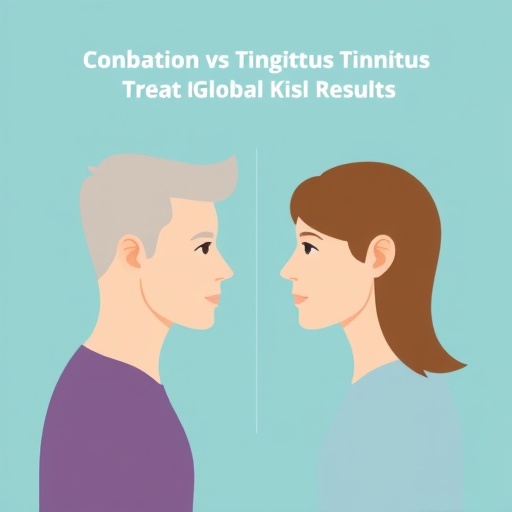Tinnitus, a condition characterized by the perception of ringing or buzzing noises in the absence of external sound, affects millions globally, yet effective treatments remain elusive. A ground-breaking international, multicentre randomised controlled trial has now sought to untangle the complex therapeutic landscape by directly comparing the efficacy of single versus combination treatments. This revolutionary study, recently published in Nature Communications, not only challenges prevailing clinical assumptions but also sets a new precedent for future tinnitus research and management.
The massive scope of this trial made it one of the most comprehensive efforts to date, involving diverse patient populations across numerous specialized centers. By adopting a parallel-arm, superiority trial design, researchers aimed to fundamentally assess whether combining therapeutic modalities provides additive benefits over employing treatments independently. This methodological rigor is particularly vital given the heterogeneous nature of tinnitus, which can stem from multiple etiologies including auditory nerve damage, neuroplasticity alterations, or even psychological stressors.
Central to the study was the comparison of standard single therapies—such as sound therapy, cognitive behavioral therapy (CBT), and pharmacological agents—against carefully curated combinations of these approaches. Each participant was rigorously assessed using validated audiological and psychoacoustic measures to objectively quantify tinnitus severity, as well as patient-reported outcomes to gauge perceived quality of life improvements. This dual approach allowed the research team to capture nuanced effects that purely objective or subjective metrics might miss.
One of the most striking revelations was that single treatments, while beneficial to specific subgroups, frequently fell short across the broader tinnitus population. Sound therapy alone, for instance, provided temporary relief for patients with less complex symptomatology but offered limited benefits to those with comorbid anxiety or depression. Conversely, CBT’s psychological focus helped mitigate the emotional burden but did not consistently translate into diminished auditory perceptions.
The combination therapies, especially those integrating sound therapy with CBT, demonstrated statistically significant superiority in reducing tinnitus loudness perception and emotional distress. Importantly, these improvements persisted throughout the follow-up period, suggesting durable effects rather than transient symptomatic relief. The study elegantly illustrated that targeting both the perceptual and cognitive-emotional dimensions of tinnitus yields more comprehensive patient outcomes.
Pharmacological interventions, though traditionally a cornerstone of tinnitus management, showed mixed efficacy in isolation. However, when combined with non-pharmacological treatments, certain medications appeared to potentiate the benefits of cognitive and auditory therapies. This synergistic interaction underscores the importance of personalized medicine approaches, tailoring treatment based on individual patient profiles and pathophysiological insights.
From a neurobiological perspective, the findings resonate with emerging evidence about tinnitus as a distributed network disorder involving auditory cortex hyperactivity and dysfunctional limbic system engagement. Combination treatments appear to exert multi-modal modulation across these neural circuits, thereby correcting aberrant neuroplastic changes that single treatments cannot sufficiently address on their own.
Beyond clinical efficacy, the trial also evaluated safety profiles and patient adherence rates, revealing that combination regimens were generally well tolerated despite increased complexity. This challenges previous assumptions that multifaceted interventions might be too burdensome, highlighting the value of patient education and multidisciplinary care teams in optimizing treatment delivery.
The implications of this research extend far beyond tinnitus, offering a robust model for addressing similarly complex, multifactorial neurological conditions. By demonstrating the power of integrative therapeutic strategies, it encourages broader adoption of combinatorial approaches not only in audiology but also in fields like chronic pain, migraine, and mood disorders.
Future research trajectories inspired by this study are poised to delve deeper into mechanistic underpinnings, leveraging advanced neuroimaging and biomarker analytics. Personalized algorithm-driven treatment protocols may soon become standard, enabling clinicians to dynamically adapt interventions based on real-time patient response data.
Furthermore, this multinational collaboration highlights the necessity of global cooperation in tackling shared healthcare challenges, particularly those involving conditions with elusive etiologies and variable presentations. Standardizing methodologies and outcome measures worldwide can accelerate discovery and translate findings into universal clinical guidelines.
In sum, this landmark trial fundamentally redefines how tinnitus should be conceptualized and treated. It compels a shift from monotherapy paradigms to a holistic, patient-centered approach that addresses the multifaceted nature of tinnitus. Patients, clinicians, and researchers alike stand to benefit from these insights, which pave the path toward more effective, sustainable relief for this often debilitating disorder.
As the scientific community digests these paradigm-shifting results, the collective hope is that future iterations of clinical care will be increasingly informed by rigorous evidence, integrating technology, psychology, and pharmacology in synergistic harmony. The era of one-size-fits-all tinnitus treatment is rapidly giving way to an era of precision and personalized therapeutics, driven by high-quality data and collaborative innovation.
With tinnitus healthcare poised on the cusp of transformation, this study represents a beacon of progress illuminating the way forward. It not only offers tangible advances in patient outcomes but also reaffirms the potential of meticulous, well-designed clinical trials to resolve longstanding medical enigmas. The convergence of science and compassion embodied here is set to resonate through the medical community and beyond for years to come.
Subject of Research: Treatment efficacy in tinnitus through comparison of single versus combination therapies.
Article Title: Single versus combination treatment in tinnitus: an international, multicentre, parallel-arm, superiority, randomised controlled trial.
Article References:
Schoisswohl, S., Basso, L., Simoes, J. et al. Single versus combination treatment in tinnitus: an international, multicentre, parallel-arm, superiority, randomised controlled trial. Nat Commun (2025). https://doi.org/10.1038/s41467-025-66165-1
Image Credits: AI Generated
Tags: efficacy of tinnitus therapiesglobal tinnitus research trialmultidisciplinary approach to tinnitus managementneuroplasticity and tinnituspatient-reported outcomes in tinnitus studiespharmacological treatments for tinnituspsychological factors in tinnitus managementrandomized controlled trial on tinnitussingle vs combination therapy for tinnitussound therapy and cognitive behavioral therapysubjective tinnitus assessment methodstinnitus treatment options





